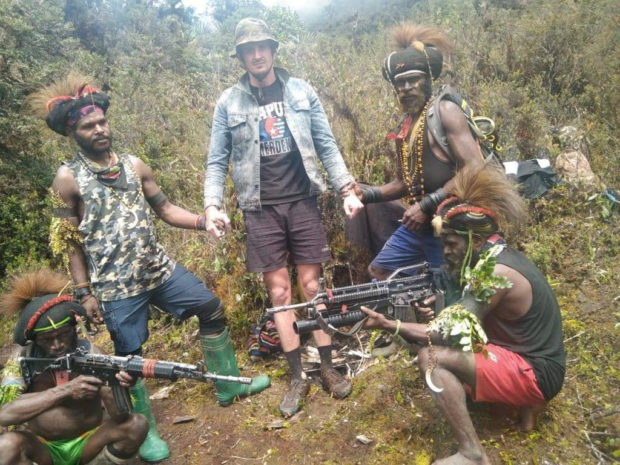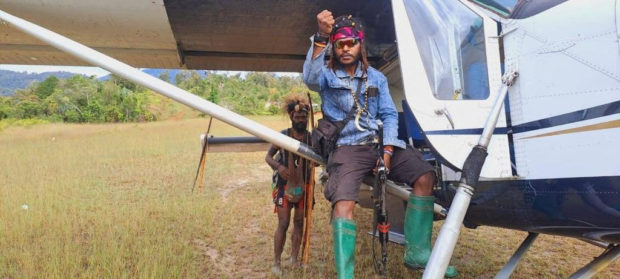Deadlier and more media savvy, separatist rebels evolve in Indonesia’s Papua

A man, identified as Philip Mehrtens, the New Zealand pilot who is said to be held hostage by a pro-independence group, stands among the separatist fighters in Indonesia’s Papua region, in this undated picture released on February 14, 2023. The West Papua National Liberation Army (TPNPB)/Handout via REUTERS/File Photo
JAKARTA — Egianus Kogoya, the dreadlocked rebel behind the kidnapping of a New Zealand pilot this month in the highlands of Indonesia’s Papua region, is at the vanguard of an increasingly dangerous and media-savvy insurgency for independence.
Separatist rebels kidnapped New Zealand pilot Philip Mehrtens, 37, after he landed his small plane in the remote Papuan highlands on February 7.
Sitting in the cockpit of the plane, Kogoya, wearing a denim jacket, bone necklace, and mirror shades, with a hand draped over a rifle, appeared to relish posing as his men documented their most high-profile kidnapping to date.
In a series of videos, Kogoya demanded the resource-rich region’s independence in return for Mehrtens’ release.
Fighters in the Indonesian, western half of New Guinea island have for decades waged a low-level battle for independence, but Kogoya and his gang have emerged as especially dangerous and unpredictable.
Article continues after this advertisement“What we are seeing is younger, new leadership among local rebel groups that is more aggressive and not necessarily strategic in the long term,” said Deka Anwar, from the Jakarta-based think tank, the Institute for Policy Analysis of Conflict (IPAC).
Article continues after this advertisementThe security ministry did not respond to requests for comment on the separatists but military spokesperson Kisdiyanto said attacks against Indonesian sovereignty by “a few” separatists were being handled.
The military has said it is preparing for a “law enforcement operation” but only as a last resort if negotiations to free Mehrtens fail.
READ: Firearms seized in Sarangani bound for West Papua – police
Separatists say their fight is legitimate because former colonial power the Netherlands promised the region it could become independent before it was annexed by Indonesia in 1963.
Indonesia says Papua is its territory after a 1969 vote supervised by the United Nations, in which 1,025 handpicked people unanimously backed its integration.
More than a half a century later, rebels are still fighting the Indonesian republic.
An estimated 500 fighters identify as members of the West Papua National Liberation Army (TPNPB), the armed wing of the Free Papua Movement (OPM).
Loosely organized and geographically fractured, the TPNPB lacks cohesion and a central leadership and command.
Instead, units in different areas operate under individual commanders, like Kogoya, who hails from a family with rebel connections – some relatives were behind the kidnapping of several foreign researchers in 1996.
For years, the separatists mounted small attacks with minimal casualties but Kogoya and his group opened a bloody new chapter in 2018 when they attacked a road-construction project killing 21 workers.
Indonesia launched a security crackdown in response, vowing to wipe out the rebels with hundreds of extra troops.
The violence forced thousands of villagers to flee, triggering a humanitarian crisis in which more than 160 people died of sickness and starvation. But in the rugged Papuan highlands, the security forces failed to track down Kogoya and his men.
Social media tool
Rebels who once brandished bows and arrows are now increasingly carrying guns, including automatic rifles seized in raids on the security forces or bought on the black market, and conducting more frequent and more lethal attacks, the IPAC said in a July report. Fifty-two members of the security forces and 34 fighters were killed between 2018 and 2021, it said.
The rebels are also taking advantage of modern communications.

Egianus Kogoya, young West Papuan rebel commander, sits on a captured plane piloted by New Zealand national Philip Mehrtens in Indonesia’s Papua region in this undated picture released on February 14, 2023. The West Papua National Liberation Army (TPNPB)/Handout via REUTERS/File Photo
Cahyo Pamungkas, a researcher from the National Research and Innovation Agency, said the separatists are using social media to get their message out.
“Social media is a tool of resistance to deliver the stories from Papua because national media is mainly dominated by perspectives from Jakarta,” he said.
“They are really media savvy,” said IPAC’s Anwar, “They want to show they are not a rag tag rebel group but have some structure, at least at the local level.”
TPNPB spokesperson Sebby Sambon said the New Zealand pilot was being well looked after and treated as “family.”
“This was his idea but we are responsible for controlling the situation,” Sambon said by telephone, referring to Kogoya’s seizure of the pilot.
READ: Indonesia president supports plan to scale back troops in restive Papua
Sambon vowed more violence unless the separatists’ demands were met, saying the TPNPB planned a “total revolution” by 2025 with widespread destruction and bloodshed.
The government did not respond to requests for comment on the rebel threat of escalation.
Some rights activists criticize the government’s response to the insurgency.
A project to get satellite coverage over the area that would help the security forces pinpoint Kogoya’s location has become embroiled in graft, a lawmaker with knowledge of the matter told Reuters on the condition of anonymity.
There are also questions about overall responsibility for policy with the government flagging a “softer approach” while the military has tended to deploy more troops in response to attacks.
“It’s not quite under the control of the civilian government there,” said Marzuki Darusman, a former attorney general turned human rights campaigner.
“It’s become military turf and that doesn’t help.”